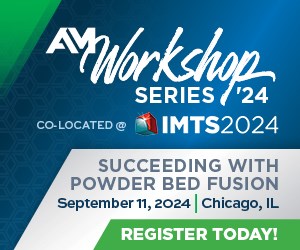AddiTec Acquires Elem Additive Solutions From Xerox
The acquisition enables AddiTec to expand its reach into liquid metal printing technology, opening up new opportunities for growth.
AddiTec’s Performance AMRC-P additive system is a forward-deployable robot cell rated for reactive materials. Photo Credit: AddiTec
AdditTec, a provider of metal additive manufacturing (AM) technology, has acquired Elem Additive Solutions from Xerox Holdings Corp. The acquirement of Elem Additive Solutions follows AddiTec’s efforts to focus on the extension of its technology portfolio to increase industrial adoption of AM.
The acquisition will enable AddiTec to expand its reach into liquid metal printing (LMP) technology, strengthening existing capabilities, opening up new opportunities for growth and enhancing the ability to serve the growing AM industry.
Since its founding, Elem Additive Solutions has been a provider of LMP technology and a key part of Xerox’s culture of innovation. From commercializing the first industrial liquid metal 3D printer to deploying it on a naval vessel, the company says it has had a history of firsts. The company’s liquid metal 3D printer, ElemX, was developed to be a safer and simpler solution, addressing supply chain resiliency for transportation, aerospace, defense and industrial manufacturing.
The shared mission and strong technological synergies between AddiTec and Elem Additive Solutions creates an opportunity to continue to innovate to the next level of liquid metal printing.
“The Elem Additive team has seen tremendous success since the organization was stood up nearly four years ago,” says Steve Bandrowczak, Xerox CEO. “In evaluating partners for this sale, it was critical we found a company with a shared mission that would sustain and advance Elem Additive’s innovation into the future. We are confident that AddiTec is the right partner and look forward to witnessing both teams’ shared success on the road ahead.”
Additec is enthusiastic about the acquisition completion. “This acquisition is a significant step for our company, we see incredible value in liquid metal print technology, and Elem Additive’s success supplements our growth efforts as we continue to develop new offerings and bring to market our turnkey metal additive manufacturing systems,” says Brian Matthews, AddiTec founder and CEO. “We are delighted to have acquired Elem Additive Solutions and will strive to create further innovative services and solutions for our customers with the addition of this exciting liquid metal printing technology.”
AddiTec will continue to support Xerox customers as the Elem Additive team transitions to the organization. AddiTec says it expects to continue to provide a service of excellence and success for its clients.
- Learn about AddiTec’s development of a portable additive manufacturing robot cell. The AMRC – P (Additive Manufacturing Robot Cell – Portable) is capable of printing parts up to 1.8 meters in dimension in a wide range of materials, including titanium.
- Read about the MSU’s collaboration with AddiTec to develop biocompatible bone implants. The collaboration focuses on enhancing Ti-6Al-4V implant properties by incorporating alloying elements such as Tricalcium phosphate to the Ti-6Al-4V melt pool matrix — which cannot be done conventionally.
- Check out this article about Siemens collaborating with Elem Additive Solutions. The partnership includes installation of a Xerox ElemX 3D printer at the Siemens’ Charlotte Advanced Technology Collaboration Hub in Charlotte, North Carolina.
Related Content
3D Printing Molds With Metal Paste: The Mantle Process Explained (Video)
Metal paste is the starting point for a process using 3D printing, CNC shaping and sintering to deliver precise H13 or P20 steel tooling for plastics injection molding. Peter Zelinski talks through the steps of the process in this video filmed with Mantle equipment.
Read MorePossibilities From Electroplating 3D Printed Plastic Parts
Adding layers of nickel or copper to 3D printed polymer can impart desired properties such as electrical conductivity, EMI shielding, abrasion resistance and improved strength — approaching and even exceeding 3D printed metal, according to RePliForm.
Read MoreAdditive Manufacturing Is Subtractive, Too: How CNC Machining Integrates With AM (Includes Video)
For Keselowski Advanced Manufacturing, succeeding with laser powder bed fusion as a production process means developing a machine shop that is responsive to, and moves at the pacing of, metal 3D printing.
Read MoreAM 101: What Is Hot Isostatic Pressing (HIP)? (Includes Video)
Hot isostatic pressing has long been used for metal castings, but is now being applied as a valuable method for closing porosity in metal 3D printed parts.
Read MoreRead Next
To Improve Performance of Compression Molded Composites, Add 3D Printed Preforms
9T Labs' Additive Fusion Technology enables the manufacture of composite structures with as much or as little reinforcement as is necessary, using 3D printed continuous fiber preforms to add strength just where needed.
Read MoreLooking to Secure the Supply Chain for Castings? Don't Overlook 3D Printed Sand Cores and Molds
Concerns about casting lead times and costs have many OEMs looking to 3D print parts directly in metal. But don’t overlook the advantages of 3D printed sand cores and molds applied for conventional metal casting, says Humtown leader.
Read MoreGE Additive Rebrands as Colibrium Additive
As part of the brand name transition, both the Concept Laser and Arcam EBM legacy brands will be retired.
Read More











.png;maxWidth=300;quality=90)












